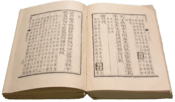Oral literature facts for kids
| Literature |
|---|
 |
| Major forms |
| Genres |
| Media |
|
| Techniques |
| History and lists |
|
| Discussion |
|
Have you ever heard a spooky story told around a campfire, a funny joke passed from friend to friend, or a song your grandparents taught you? If so, you've experienced oral literature.
Oral literature, also known as folk literature, is a special kind of literature that is shared by speaking or singing, rather than being written down in a book. It includes all the stories, legends, poems, and songs that are passed down from one generation to the next through word of mouth. Even though many of these stories have been written down over time, they started as spoken tales.
Contents
The Power of Spoken Stories
Before Books Were Common
Long ago, before most people could read or write, storytelling was the main way to share important information, history, and entertainment. These spoken traditions were the "library" of a community.
This type of literature included many forms that are still popular today:
- Folk Epics: Long poems about heroes and amazing adventures.
- Folklore: Traditional beliefs, customs, and stories of a community. This includes fairy tales, fables (stories with a moral, often with animal characters), and myths.
- Proverbs: Short, wise sayings like "look before you leap."
- Folksongs: Traditional songs that tell a story or express an emotion.
Oral Stories in the Modern World
Even though we have books, movies, and the internet, oral literature is still a big part of our lives.
- Bedtime Stories: Stories told to children at night are often a form of oral tradition within a family.
- Jokes: Jokes are almost always shared by speaking and change as they are passed from person to person.
- Urban Legends: These are modern, spooky, or funny stories that people swear are true and spread by word of mouth.
- Poetry Slams: This is a type of performance poetry where poets perform their work live on stage. The performance is just as important as the words.
When people move to new countries, they bring their spoken stories and songs with them. These traditions often mix with new cultures and create exciting new forms of art, like new styles of music.
Orature: More Than Just Words
In the 1960s, a scholar from Uganda named Pio Zirimu came up with the term orature. He felt that the phrase "oral literature" was a bit of a contradiction, since "oral" means spoken and "literature" usually means written.
Zirimu wanted a word that captured the idea that these stories are also a performance. Think about a great storyteller. They don't just say the words; they use their voice, facial expressions, and hand gestures to bring the story to life. The audience's reaction is also part of the experience. Orature reminds us that this type of storytelling is a living, breathing art form that happens in a community.
Studying Spoken Stories
While telling stories is as old as humanity, the formal study of oral literature is much more recent. In the 20th century, scholars began to seriously study how these traditions were created and shared.
One famous researcher, Albert B. Lord, published a book in 1960 called The Singer of Tales. He studied storytellers, known as bards, in Eastern Europe who could perform epic poems that were thousands of lines long. He discovered that they didn't just memorize the entire poem. Instead, they learned patterns, key phrases, and a general story outline. Each time they performed, they would recreate the story on the spot, making every telling a unique event.
Storytelling Without Sound
Storytelling isn't just about spoken words. In Deaf culture, people use sign languages to share stories, poems, and jokes.
This is a form of visual storytelling that is passed down from person to person without being written. Just like oral literature, it is a living tradition that depends on the skill of the performer and the connection with the audience. It shows that the spirit of sharing stories is a universal human experience.

